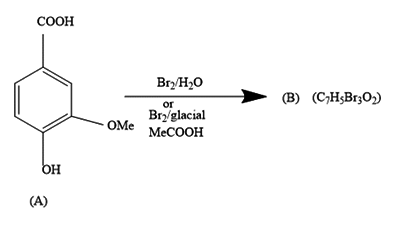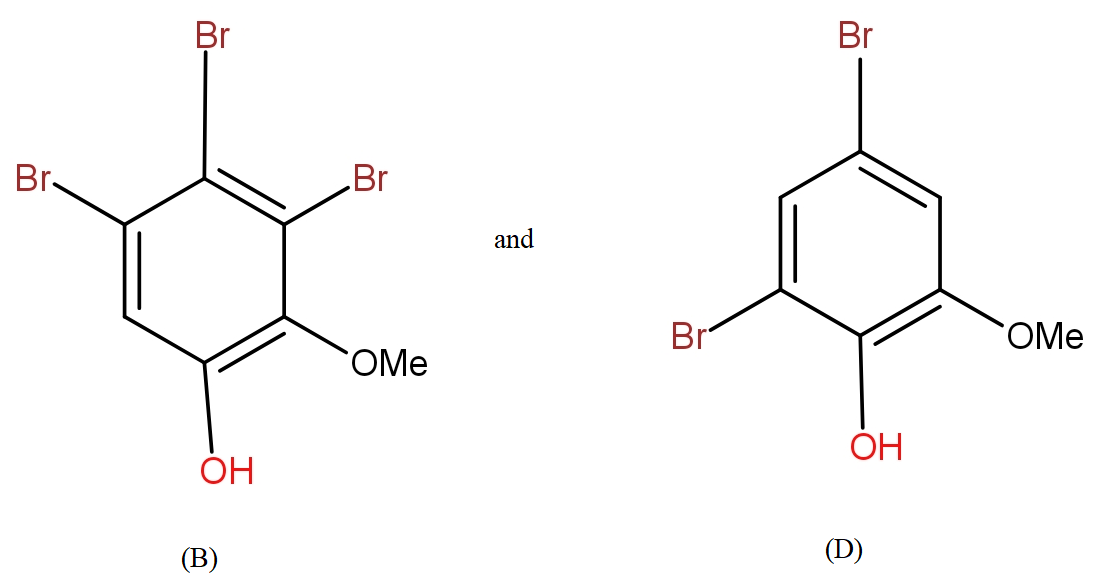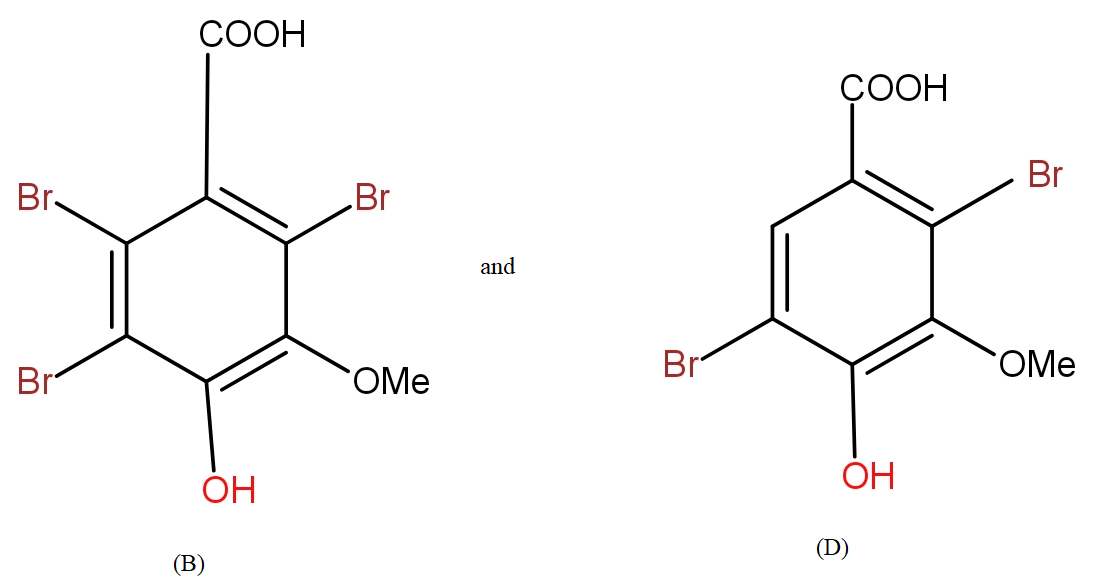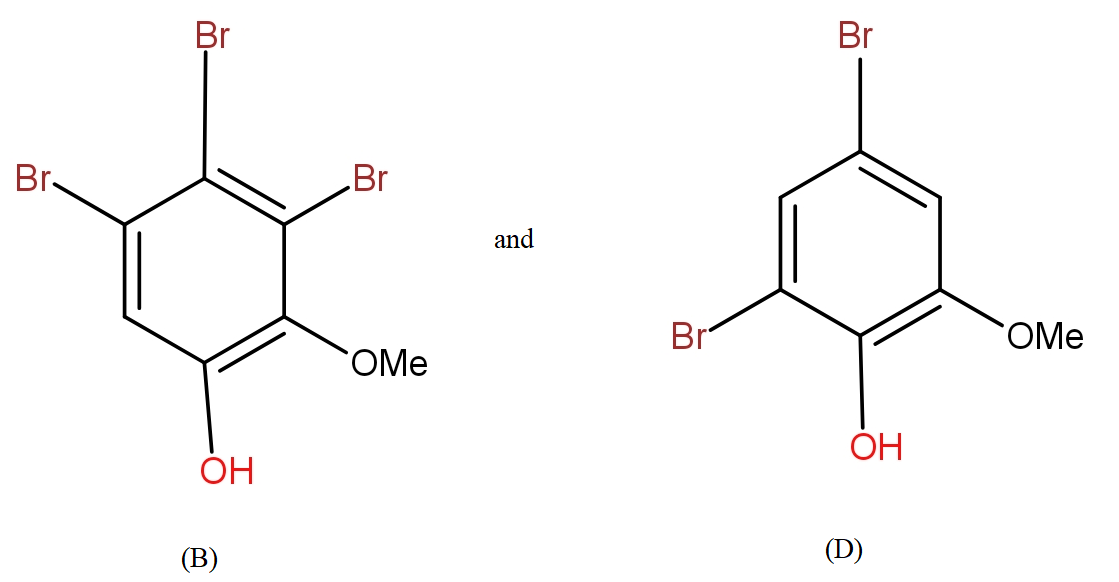
Which of the following statements is/are correct about the following reactions?


a.) The products (B) and (D) respectively, are :

b.) The products (B) and (D) respectively, are :

c.) Phenol can not be chlorinated because the ring is susceptible to oxidation by $C{l_2}$.
d.) The formation of (C ) from (B) proceeds by Arsn reaction (addition – elimination).




Answer
580.8k+ views
Hint : The reaction is about bromination of substituted benzoic acid. When we add bromine water to 3-methoxy-4-hydroxy benzoic acid, Bromine atom gets substituted on the benzene ring in accordance with the carboxylic group.
Complete answer :
Let us move step by step to the answer.
In the first reaction, we are given a reaction in which bromine water is added to 3-methoxy-4-hydroxy benzoic acid. The product formed contains seven carbon atoms, five hydrogen atoms, three bromine atoms and two oxygen atoms.
It comes under chemical reactions of carbonyl compounds. As we all know benzene is much stable due to resonance that it does not undergo addition reactions. It undergoes a substitution reaction in which H atom gets replaced by the incoming group.
The COOH group being the most dominating will decide the substitution of bromine atoms.
Further, from the options only, it is clearly visible that the compound in option a.) contains the equal number of atoms of each type as given in question in product (B). The molecular formula supports the answer a.).
Even for the second reaction, the option a.) shows an equal number of atoms.
So, the option a.) is the correct answer.

Note :
The COOH group is meta directing in nature. So, it will direct the incoming bromine atoms to its meta position. While the OH and OMe groups are ortho and para directing in nature. In that option b.) could also be the answer but here molecular formula does not support it.
Further, decarboxylation with bromine water is uncommon since it is an oxidising agent.
Complete answer :
Let us move step by step to the answer.
In the first reaction, we are given a reaction in which bromine water is added to 3-methoxy-4-hydroxy benzoic acid. The product formed contains seven carbon atoms, five hydrogen atoms, three bromine atoms and two oxygen atoms.
It comes under chemical reactions of carbonyl compounds. As we all know benzene is much stable due to resonance that it does not undergo addition reactions. It undergoes a substitution reaction in which H atom gets replaced by the incoming group.
The COOH group being the most dominating will decide the substitution of bromine atoms.
Further, from the options only, it is clearly visible that the compound in option a.) contains the equal number of atoms of each type as given in question in product (B). The molecular formula supports the answer a.).
Even for the second reaction, the option a.) shows an equal number of atoms.
So, the option a.) is the correct answer.

Note :
The COOH group is meta directing in nature. So, it will direct the incoming bromine atoms to its meta position. While the OH and OMe groups are ortho and para directing in nature. In that option b.) could also be the answer but here molecular formula does not support it.
Further, decarboxylation with bromine water is uncommon since it is an oxidising agent.
Recently Updated Pages
Master Class 12 English: Engaging Questions & Answers for Success

Master Class 12 Business Studies: Engaging Questions & Answers for Success

Master Class 12 Economics: Engaging Questions & Answers for Success

Master Class 12 Social Science: Engaging Questions & Answers for Success

Master Class 12 Maths: Engaging Questions & Answers for Success

Master Class 12 Chemistry: Engaging Questions & Answers for Success

Trending doubts
What are the major means of transport Explain each class 12 social science CBSE

Which are the Top 10 Largest Countries of the World?

Draw a labelled sketch of the human eye class 12 physics CBSE

Explain sex determination in humans with line diag class 12 biology CBSE

The pH of the pancreatic juice is A 64 B 86 C 120 D class 12 biology CBSE

Explain sex determination in humans with the help of class 12 biology CBSE




